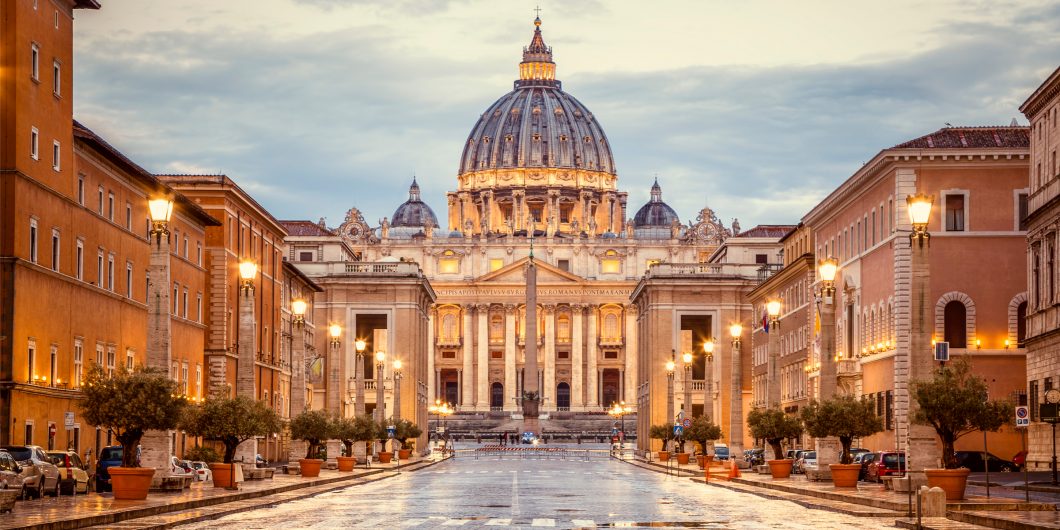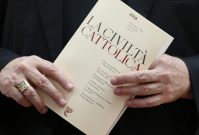What the Church’s hierarchy has lacked is not the canonical mechanisms necessary for dealing with abuse, but a zeal for justice.
The Catholic Dilemma: Exit, or Voice and Loyalty?
As Anthony Gill argues in his piece entitled “Divine Diseconomy,” the Catholic Church represents something unique in the history of social organizations. Its uniqueness follows from a rather difficult constraint that is enshrined in the name catholic. The term kata holos is Greek for something that concerns the whole group, in this case the billion or so Catholics worldwide. The primary emphasis of this term is a focus on that narrow range of things legitimized by the consensus of beliefs among the body of believers as represented by the Vatican. While the majority of the practice of the faith expands on this core consensus and will continue to do so, the pontiff of the Church is importantly charged with ensuring the unity of the Church in this sense of kata holos. The recent move by Pope Francis to severely restrict the celebration of the traditional Latin Mass (also known as extraordinary form), should be understood as an attempt to do just that, ensuring the unity of the Church.
Gill’s discussion of Pope Francis’s recent move focuses on how efforts to limit the Latin mass alienate those believers who, because they appear to be among the most committed members, are a great asset to the Church. His reading of religion as a marketplace is a conventional take in the rational choice tradition that incorporates factions as a natural result of institutional progress. In this way, he examines the Church in the manner one would consider the res publica—as a public forum that represents and balances competing voices. What is unique, as Gill admits, is the continuity of the institution of the Roman Church over time. His approach emphasizes short-term market pressures to change rather than enduring structures of the institution.
The pope’s motu proprio issued on July 16, 2021 abrogates the right of priests to decide for their parishioners when to celebrate the 1962 missal, which represented an order of mass that had been largely unchanged for 1400 years until the second Vatican council. In addition, the Pope’s apostolic letter stipulates guidelines for bishops to authorize the use of that form of worship, guidelines which restrict but do not eliminate it. Because it reverts the course set by the previous pope, Bishop Rob Mutsaerts of the Netherlands has called Pope Francis’s letter a declaration of war on the Radical Traditionalists (Rad Trads) in the Catholic Church.
This recent development might look like the suppression of a popular faction that defies explanation in a rational analysis of religion. For Catholics, though, the unity of the Church has to be the pontiff’s key charge, and to that end, his actions are more analogous to marriage counseling than they are to dating. To emphasize diversity and competition is to view the evolution of doctrine in Darwinian terms of survival of the fittest. The difference in orientation that the kata holos represents changes important elements of the rational analysis of the Pope’s actions and requires a defense. Drawing on Albert O. Hirschman’s triadic phrase, Exit, Voice, and Loyalty I defend the analytical viewpoint represented in the Pope’s decision here.
Exit
Choice is built into the structure of the Catholic Church. The individual parishioner can either submit to his parish priest or find a new parish and a new priest. Further, if a priest disagrees with his bishop, he can appeal to canon law to dispute this. The bishops have conferences for national jurisdictions and there are even synods that represent whole regions of the world. This process is distinct from the tradition that I associate with the republican form of government, which emphasizes the representation of evolving preferences rather than tradition. To be Catholic, however, is to embrace this process, and the shackles that may seem to come with it. It is also to accept the slow-moving change referred to by G.K. Chesterton as the “democracy of the dead.”
Holding to this version of what it means to be Catholic can come with some uncomfortable recognitions throughout history. The Inquisitions of Galileo Galilei between 1610 and 1633 put a fine point on the Catholic Church’s interpretation of the role of tradition. In that episode, the church was facing the indisputable fact that Copernican heliocentrism was simply better able to predict planetary motion than biblical tradition. Famously, Galileo sided with the momentum of history and pulled no punches in lampooning the then Pope Urban VIII. He even used direct quotes in his published Dialogue Concerning the Two Chief World Systems and, mocking the pontiff, attributed them to a character called Simplicio. Galileo’s mocking was so poorly disguised that the entire episode has come down through history celebrating Galileo as a figure of valor to the scientific community. What is underappreciated by most, however, is the fact that the famous scientist ultimately argued that the natural world could not be in contradiction with the faith that he maintained his whole life. This is where Hirschman’s triad comes in. Not even Galileo suggested exit as a response to what he thought was a clear mistake in the Vatican’s procedural approach. Since exit is not an option, and that is essentially what it means to espouse Roman Catholicism, then loyalty and voice remain.
A Roman Catholic must reconcile with Rome. As the Galileo episode demonstrates, that reconciliation is complex. The Pope has the authority to act according to his vocation and with the best judgment as his own flawed understanding and his acceptance of grace can allow. Popes can be wrong. Infallibility is a rarely invoked principle of dogma and reserved for the reconciliation of Roman Catholics on points of universal importance for people of the faith. Any stronger defense of the seat of St. Peter would be indefensible considering the historical record.
Voice
To express voice in the church, the second element of Hirschman’s triad, is to take a position. As mentioned earlier, all laity are free to find their voice in a parish where the pastor can best minister to their need. Laypersons are not free, however, to declare themselves priests. To found a separate form of worship would be to put oneself outside of reconciliation with Rome, as protestants have done. The ordination rite of all Catholic priests submits them at the very least to the discretion of the local Bishop who himself rose through the ranks as a person in accord with the hierarchy of the church. This is what makes the kata holos something different than a type of republic where change and contestability are invited, even if the republic must be reformed from first principles.
For the laity to attempt to create grass roots change within the organization is to view it as a res publica and not as something constrained by shared dogma, the kata holos.
The Rad Trads in the Catholic Church can seek those pastors that support their preference for the 1962 missal. This is voice. What they cannot do, if they want to remain Catholic, is to insist that the Mass of Paul VI, also called the ordinary form, is somehow inferior. To do so is to create faction in the kata holos and rebel against tradition in a way that is unbecoming of a “Traditionalist.” Bishop Robert Barron has explained both the underappreciated merits of Vatican II and the ordinary form mass it defined as well as the high degree of unanimity that the Second Vatican Council reached in the final vote in 1962 (2147 for with 4 against).
Rad Trads place themselves under the 2000-year tradition of the Church, pointing to a magisterium of the Church that is divinely directed, while suggesting that the supreme pontiff’s actions for the protection of doctrine are a sign of heresy. But you cannot have it both ways: to reject the Vatican is to be a protestant. For the laity to attempt to create grassroots change within that organization is to view it as a res publica and not as something constrained by shared dogma, the kata holos. The Roman Church’s organizational structure goes beyond something that is one more secular venue for political action. To reign in those that appear to threaten the 1962 Second Vatican council is the most Catholic thing the Pope can do.
Loyalty
This last point is the crux of my argument. Radical Traditionalist Catholics would do themselves a great service by understanding what loyalty means in the Hirschman triad. GK Chesterton’s defense of tradition and Galileo’s example offer guidance here. The kata holos demands an understanding that tradition is slow to change and that to be Catholic is to assert supreme confidence in the magisterium of the church, even when one disagrees with it, as Galileo did. The concept of loyalty contains the insight that the truth will win out in the fullness of time.
Furthermore, true voice also requires loyalty. To maintain voice as a functioning mechanism within the organization of a 2000-year-old church, those expressing opposition have to remain in the Church even when they do not find a hearing. The Council of Trent could have reconciled with Luther’s sola gratia (grace alone) by amending his proposition to prima gratia (the special status of grace). Instead, the conversation ended when Luther separated. The Catholic church had to pursue reformation in response to but apart from Luther. A similar fate rests with anyone not willing to trust the magisterium of the church. The Church is simply not a secular governance organization.
The public thing, the res publica, is a wholly different tradition in collective action. The res publica is a matter of concern for secular political institutions. The republican approach does not require conceptual unanimity the way that the kata holos does. In this way, the res publica is a much humbler claim about agreement in collective action. It is majoritarian. All flaws in republican governance can be corrected by a reversal in the next administration. We even stand ready to provide a wholly new republic any time when the old one no longer meets our perceived needs. The claim of an enduring legacy over 2000 years does not allow such cavalier experimentation. In the republic, we must have our voice heard or we exit. Roman Catholics that wish for this same latitude have many options in any of the more than 45,000 Christian confessions who would welcome them with open arms. Indeed, many have already left.
The question then remains, what should the Rad Trads do if they want to reconcile with the Church? I would argue that they should learn from Galileo and not mock the Pope. Even better, they may want to follow in Johannes Kepler’s footsteps, who threaded this needle with even greater skill. While he made a significant mark on science, his legacy hardly notes any conflict with the Church.
More practically, Rad Trads may identify a priest that shares their same concerns. Praising what others in the structure are doing right bolsters voice. A further expression of loyalty would be to celebrate fellow believers who, after attending the ordinary rite of mass, notice no deficiency whatsoever in the liturgy. To find common ground is an expression of the kata holos.
Like Galileo, some are called to articulate necessary changes to the historical arc of the church, and the organization requires this. But the lessons of Kepler, Galileo, and Luther can help us better understand the long endurance of the Roman Church.
The Church will face more divisive issues in the near future. The German Bishops pose an entirely different challenge with their recent moves to revolutionize the church’s teaching. To imagine that the Church will maintain its many divisions without fracture is difficult. I would kindly submit, however, that Hirschman’s triad points to a stark choice when loyalty is dismissed in favor of exit.



